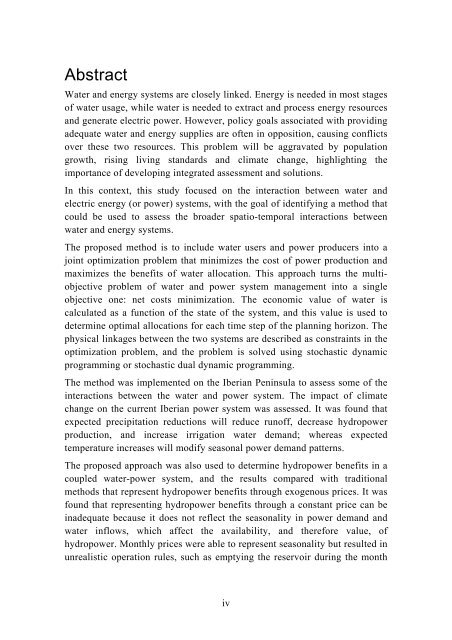A framework for joint management of regional water-energy ... - Orbit
A framework for joint management of regional water-energy ... - Orbit
A framework for joint management of regional water-energy ... - Orbit
You also want an ePaper? Increase the reach of your titles
YUMPU automatically turns print PDFs into web optimized ePapers that Google loves.
Abstract<br />
Water and <strong>energy</strong> systems are closely linked. Energy is needed in most stages<br />
<strong>of</strong> <strong>water</strong> usage, while <strong>water</strong> is needed to extract and process <strong>energy</strong> resources<br />
and generate electric power. However, policy goals associated with providing<br />
adequate <strong>water</strong> and <strong>energy</strong> supplies are <strong>of</strong>ten in opposition, causing conflicts<br />
over these two resources. This problem will be aggravated by population<br />
growth, rising living standards and climate change, highlighting the<br />
importance <strong>of</strong> developing integrated assessment and solutions.<br />
In this context, this study focused on the interaction between <strong>water</strong> and<br />
electric <strong>energy</strong> (or power) systems, with the goal <strong>of</strong> identifying a method that<br />
could be used to assess the broader spatio-temporal interactions between<br />
<strong>water</strong> and <strong>energy</strong> systems.<br />
The proposed method is to include <strong>water</strong> users and power producers into a<br />
<strong>joint</strong> optimization problem that minimizes the cost <strong>of</strong> power production and<br />
maximizes the benefits <strong>of</strong> <strong>water</strong> allocation. This approach turns the multiobjective<br />
problem <strong>of</strong> <strong>water</strong> and power system <strong>management</strong> into a single<br />
objective one: net costs minimization. The economic value <strong>of</strong> <strong>water</strong> is<br />
calculated as a function <strong>of</strong> the state <strong>of</strong> the system, and this value is used to<br />
determine optimal allocations <strong>for</strong> each time step <strong>of</strong> the planning horizon. The<br />
physical linkages between the two systems are described as constraints in the<br />
optimization problem, and the problem is solved using stochastic dynamic<br />
programming or stochastic dual dynamic programming.<br />
The method was implemented on the Iberian Peninsula to assess some <strong>of</strong> the<br />
interactions between the <strong>water</strong> and power system. The impact <strong>of</strong> climate<br />
change on the current Iberian power system was assessed. It was found that<br />
expected precipitation reductions will reduce run<strong>of</strong>f, decrease hydropower<br />
production, and increase irrigation <strong>water</strong> demand; whereas expected<br />
temperature increases will modify seasonal power demand patterns.<br />
The proposed approach was also used to determine hydropower benefits in a<br />
coupled <strong>water</strong>-power system, and the results compared with traditional<br />
methods that represent hydropower benefits through exogenous prices. It was<br />
found that representing hydropower benefits through a constant price can be<br />
inadequate because it does not reflect the seasonality in power demand and<br />
<strong>water</strong> inflows, which affect the availability, and there<strong>for</strong>e value, <strong>of</strong><br />
hydropower. Monthly prices were able to represent seasonality but resulted in<br />
unrealistic operation rules, such as emptying the reservoir during the month<br />
iv
















